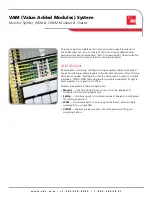
©
National Instruments Corporation
47
NI cDAQ-9172 User Guide and Specifications
Buffered Period Measurement
Buffered period measurement is similar to single period measurement,
but buffered period measurement measures multiple periods.
The counter counts the number of rising (or falling) edges on the Source
input between each pair of active edges on the Gate input. At the end of
each period on the Gate signal, the counter stores the count in a hardware
save register. The NI cDAQ-9172 transfers the stored values to host
memory.
The counter begins when it is armed. The arm usually occurs in the middle
of a period of the Gate input. So the first value stored in the hardware save
register does not reflect a full period of the Gate input. In most applications,
this first point should be discarded.
Figure 22 shows an example of a buffered period measurement.
Figure 22.
Buffered Period Measurement
Note
If you are using an external signal as the Source, at least one Source pulse should
occur between each active edge of the Gate signal. This condition ensures that correct
values are returned by the counter. If this condition is not met, consider using duplicate
count prevention, described in the
section.
For information about connecting counter signals, refer to the
section.
SOURCE
GATE
Counter Value
Buffer
1
1 2
3
3
2
3
3
1 1
2
2
2
2
3
3
2
(Discard) (Discard)
(Discard)
3
Counter Armed











































